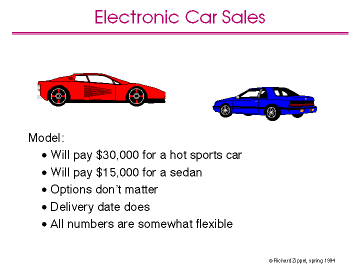
Back to the previous slide, on to the next slide or up to the communications overview
Negotiating programs behave rather differently from conventional programs. To be precise, consider the situation of needing to purchase a car. In the world of electronic commerce we expect the buyer to develop a neogiating agent using special tools. This neogtiating agent would be made available on the network and anyone with a car to sell would interact with the negotiating agent to see how close of a match there is. After a period of time the buyer would look at the best offers his or her agent has found and decide whether to pursue them in person, or to refine the negotiating agent and continue.
The negotiating position modeled by the negotiating agent involves a number of different aspects. For instance, the buyer might be willing to pay a moderate amount of money for a hot sports car, but is expecting to purchase a sedan at a cheaper level. Options, delivery dates and other aspects of the car will influence how interested the buyer is in the vehicle and how much he or she is willing to pay.
A program that captures all these different trade-offs is difficult to express in a procedural language. What is the proper language for expressing negotiating agents? Also, the negotiating agent needs to protect the details of the negotiating position it represents from the sellers. How is this best done? Can cryptographic protocols or randomization be used?
Richard Zippel